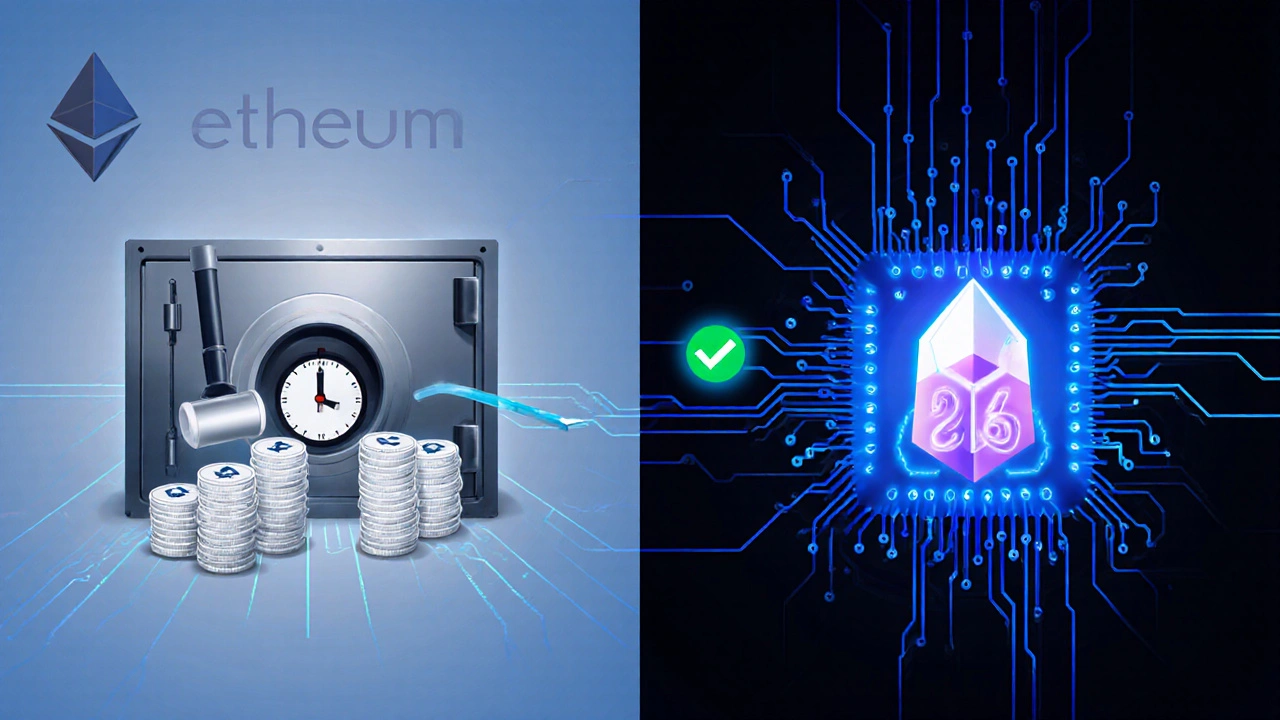When you hear people talk about layer 2 scaling, they’re really talking about a set of tricks that move work off the main blockchain while still keeping the security guarantees of the base layer. Layer 2 scaling is a collection of protocols that sit atop a base chain - like Ethereum or Bitcoin - and handle transactions or computation elsewhere, only posting summaries back to the main chain. This approach lets networks process more transactions per second, cut fees, and keep confirmation times low.
Key Takeaways
- Layer 2 solutions move the bulk of work off‑chain but rely on the base layer for finality.
- Rollups (optimistic and zk) are the dominant L2 tech on Ethereum today.
- State channels excel for frequent, private interactions between a fixed set of participants.
- Sidechains offer full autonomy at the cost of weaker security guarantees.
- Choosing the right L2 depends on trust assumptions, latency needs, and the type of application.
Why Layer 2 Matters
Both Ethereum a programmable blockchain that supports smart contracts and decentralized applications (dApps) and Bitcoin the first cryptocurrency, designed primarily for peer‑to‑peer value transfer face a fundamental trade‑off: increasing block size or decreasing block time improves throughput but can harm decentralization. Layer 2 sidesteps this by keeping the base chain lean while still leveraging its security.
In practical terms, a congested network can push transaction fees to dozens or even hundreds of dollars. With a good L2, the same operation might cost pennies, opening the door for micro‑payments, gaming, and massive DeFi activity.
Main Types of Layer 2 Solutions
There are four big families you’ll hear about: Rollup a solution that batches many transactions off‑chain, posts a succinct proof or claim on‑chain, and lets the base layer verify it, State Channel a two‑way conduit where participants exchange signed messages off‑chain and settle the final state on‑chain, Sidechain an independent blockchain that runs its own consensus but is anchored to a main chain via bridges, and Plasma a framework for creating hierarchical child chains that periodically commit to the root chain. The first three dominate today; Plasma is mostly experimental.
How Rollups Work
Rollups come in two flavors: Optimistic Rollup assumes transaction data is valid by default and only runs a fraud‑proof if someone challenges it and ZK‑Rollup generates a succinct zero‑knowledge proof that mathematically guarantees correctness before posting to the base chain. Both bundle hundreds or thousands of transactions into a single on‑chain calldata, slashing the data footprint.
In an optimistic rollup, a user submits a transaction to the rollup sequencer. The sequencer adds it to a batch, publishes the batch’s root hash on Ethereum, and waits a challenge window (usually 1‑7 days). If no one disputes, the batch is considered final. If a fraud proof appears, the offending transaction is rolled back and the challenger is rewarded.
Zero‑knowledge rollups skip the waiting period. The operator computes a zk‑SNARK or zk‑STARK that proves the new state follows the rollup’s rules. The proof, along with the new state root, is posted on‑chain instantly, giving finality in seconds.

State Channels Explained
State channels shine when two (or a small set) of participants need to exchange many messages quickly and privately. Think of a poker game, a gaming marketplace, or recurring micropayments.
To open a channel, each party locks a certain amount of cryptocurrency in a smart contract on the base chain. They then exchange signed state updates off‑chain. Because each update is signed, neither side can cheat without the other noticing. When the participants are done, they submit the latest state to the contract, which distributes the locked funds accordingly.
The biggest advantage is that no on‑chain transaction is needed for every update - only the opening and closing. However, the downside is that you need to be online (or have a watchtower) to contest a dishonest close.
Sidechains vs Rollups: A Quick Comparison
| Aspect | Optimistic Rollup | ZK‑Rollup | Sidechain | State Channel |
|---|---|---|---|---|
| Security Model | Relies on Ethereum fraud proofs | Validity proofs verified on‑chain | Independent consensus (weaker security) | On‑chain contract enforces settlement |
| Finality Speed | 1‑7 day challenge period | Seconds to minutes | Variable (depends on sidechain) | Instant off‑chain, final on‑chain when closed |
| Typical Use Cases | DeFi, NFTs, DEXes | High‑value transfers, privacy‑focused apps | Gaming, custom VM, experimental features | Micropayments, gaming, exchange of private data |
| Trust Assumptions | Honest majority of sequencers + challenge mechanism | Cryptographic validity of zk‑proofs | Trust in sidechain validators | Both parties must stay online or delegate monitoring |
| Scalability (TPS) | ~2,000‑4,000 | ~5,000‑10,000 | Varies, often >10,000 | Unlimited off‑chain (bounded by channel capacity) |
Design Trade‑offs You Should Know
Every L2 makes a compromise. Optimistic rollups trade instant finality for a simple fraud‑proof system; they’re easier to build but suffer from the challenge delay. ZK‑rollups give fast finality, but generating zero‑knowledge proofs is computationally heavy and can raise costs for developers.
Sidechains provide full control over consensus, which is great for custom features, but you now have to trust that the sidechain’s validators are honest. State channels eliminate on‑chain congestion entirely for participants, yet they don’t scale well to large, open‑ended user bases.
Choosing the right solution often starts with answering three questions:
- Do I need the strongest security or can I accept a lighter trust model?
- How important is transaction speed for my users?
- Will the application involve many unique users or just a fixed group?
Answering these helps you map the problem to the appropriate L2 family.

Implementation Steps for Developers (Ethereum Focus)
- Identify the most suitable L2 type based on the trade‑offs above.
- Pick a well‑audited bridge or SDK. For rollups, popular choices are Arbitrum an optimistic rollup platform on Ethereum and StarkNet a zk‑rollup network built on StarkWare technology.
- Write your smart contracts using the same Solidity version but target the L2’s bytecode environment (most L2s support the EVM).
- Deploy to a testnet (e.g., Arbitrum Goerli, StarkNet Sepolia) and run cross‑chain integration tests.
- Configure your front‑end to point to the L2 RPC endpoint and handle wallet connections (MetaMask now supports multiple networks out‑of‑the‑box).
- Monitor gas costs and transaction latency; adjust batching strategies if needed.
- Once stable, launch on mainnet and announce the bridge path for users.
Remember to audit any bridge logic - cross‑chain exploits have drained millions in the past.
Common Pitfalls and How to Avoid Them
- Ignoring the challenge window. For optimistic rollups, users may think a transaction is final when it’s still subject to dispute. Build UI cues that clearly show pending status.
- Over‑relying on a single validator. Diversify sequencer or sidechain validators to reduce centralization risk.
- Messing up nonce management in state channels. Always sync the latest signed state before closing; use watchtowers if parties can go offline.
- Assuming bridge security equals base‑chain security. Bridges are separate attack surfaces - keep funds on L2 only as long as needed.
Future Outlook (2025 and Beyond)
By late 2025, Ethereum’s roadmap aims to integrate data‑availability layers that blur the line between L1 and L2. Projects like Celestia a modular data‑availability network that can serve as a shared layer for rollups are already live, promising cheaper calldata and even higher throughput.
Meanwhile, the Bitcoin ecosystem is experimenting with Lightning Network a state‑channel network that enables near‑instant Bitcoin payments, which essentially acts as a massive web of interconnected state channels.
Expect more hybrid solutions: rollups that periodically anchor to sidechains, or sidechains that inherit zk‑proof data‑availability from a shared L1. The core idea stays the same - push work off‑chain, keep security on‑chain.
Frequently Asked Questions
What exactly is a rollup?
A rollup batches many transactions off‑chain, creates a concise proof or claim, and posts that single piece of data to the base blockchain. The base chain then verifies the proof (or can challenge it) and finalizes the batch.
How do optimistic rollups differ from zk‑rollups?
Optimistic rollups assume transactions are correct and only run a fraud‑proof if someone disputes a batch, leading to a delay before finality. ZK‑rollups generate a mathematical proof that the batch is valid, so they achieve near‑instant finality but require heavier cryptographic computation.
Can I use a state channel for more than two users?
Yes, multi‑party state channels exist (sometimes called “virtual channels”), but they become more complex to manage because every participant must sign each state update. Most developers stick to two‑party channels for simplicity.
Are sidechains less secure than rollups?
Sidechains run their own consensus, so their security depends on the validators they choose. Rollups inherit the security of the base chain (Ethereum or Bitcoin), making them generally safer for high‑value assets.
What is the role of bridges in layer 2 scaling?
Bridges lock assets on the base chain and mint corresponding tokens on the L2, allowing users to move value back and forth. They act as the gateway, but they are also a point of vulnerability, so audits are crucial.
Will layer 2 solutions replace layer 1 eventually?
Not likely. Layer 1 provides the settlement and security base; layer 2 builds on it to improve capacity. Think of L1 as the foundation and L2 as the floors you add on top.






